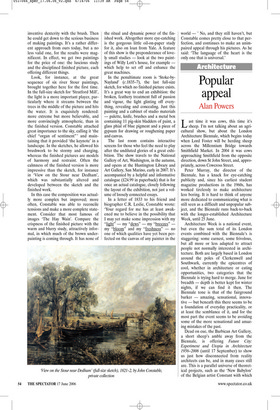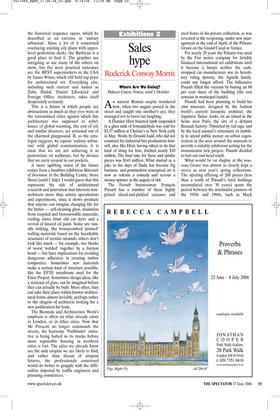Popular appeal
Alan Powers
Last time it was cows, this time it’s sheep. I’m not talking about an agricultural show, but about the London Architecture Biennale, which begins today when Lord Foster will be herding sheep across the Millennium Bridge towards Smithfield Market. In 2004 it was cows approaching Smithfield from the opposite direction, down St John Street, and, appropriately, across Cowcross Street.
Peter Murray, the director of the Biennale, has a knack for eye-catching publicity and, since his earliest student magazine productions in the 1960s, has worked tirelessly to make architecture less boring. It is hard to think of anyone more dedicated to communicating what is still seen as a difficult and unpopular subject, and the Biennale runs back-to-back with the longer-established Architecture Week, until 25 June.
Architecture Week is a national event, but even the sum total of its London events combined with the Biennale’s is staggering: some earnest, some frivolous, but all more or less adapted to attract people not normally interested in architecture. Both are largely based in London around the poles of Clerkenwell and Southwark, currently the epicentres of cool, whether in architecture or eating opportunities, two categories that the Biennale is trying hard to merge. June for breadth — depth is better kept for winter nights, if we can find it then. The Biennale tone is that of the fairground barker — amazing, sensational, innovative — but beneath this there seems to be a foundation of everyday practicality, or at least the semblance of it, and for the most part the event seems to be avoiding some of the more sensational and amazing mistakes of the past.
Dead on cue, the Barbican Art Gallery, a short sheep’s amble away from the Biennale, is offering Future City: Experiment and Utopia in Architecture 1956–2006 (until 17 September) to show us just how disconnected from reality architects can be, and in many cases still are. This is a parallel universe of theoretical projects, such as the ‘New Babylon’ of the Belgian artist Constant with which the historical sequence opens, which he described as an exercise in ‘unitary urbanism’. Since a lot of it concerned overlaying existing city plans with upperlevel pedestrian decks, the Barbican is a good place to find it. The graphics are intriguing as are many of the others on show, but the most practical outcomes are the BEST supermarkets in the USA by James Wines, which still hold top prize for architectural wit. Everything else, including such current star names as Zaha Hadid, Daniel Libeskind and Foreign Office Architects, takes itself desperately seriously.
This is a future in which people are abstractions as much as they ever were in the rationalised cities against which this architecture was supposed to rebel. Issues of global warming, the end of oil, and similar disasters, are screened out of the charmed playground. If, as the catalogue suggests, we equate ‘unitary urbanism’ with global communication, it is clear that we are not achieving it as pedestrians on walkways, but by devices that we carry around in our pockets.
A more uplifting vision of the future comes from a humbler exhibition Materials of Invention at the Building Centre, Store Street (until 1 July). I would guess that this represents the side of architectural research and innovation that interests nonarchitects more than artistic speculations and experiments, since it shows products that anyone can imagine changing life for the better — self-cleaning glass, insulation from recycled and biorenewable materials, roofing slates from old car tyres and a revival of linseed oil paint. Some are visually striking, like honeycombed ‘printed’ walling materials based on the breathable structures of termite mounds; others don’t look like much — for example, two blocks of wood ‘welded’ together by a friction bond — but have implications for avoiding dangerous adhesives in creating timber composites. Sometimes new materials make a certain kind of structure possible, like the EFTE membrane used for the Eden Project. Sometimes design ideas, like a staircase of glass, can be imagined before they can actually be built. More often, they can take their place within known architectural forms almost invisibly, perhaps rather to the chagrin of architects looking for a new justification for form.
The Biennale and Architecture Week’s emphasis is often on what already exists in London, or in other cities. Now that Mr Prescott no longer commands the streets, his fearsome ‘Pathfinder’ initiative is being halted in its tracks before more repairable housing in northern cities is lost. The cities we already know are the only utopias we are likely to find, and rather than dream of utopian futures, the professionals concerned would do better to grapple with the difficulties imposed by traffic engineers and planning committees.



















































































 Previous page
Previous page